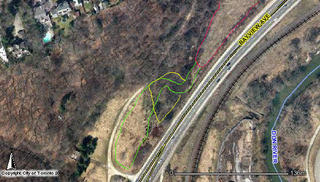Friends of the Don East York has had a long history of advocacy and environmental projects in Toronto. They started up in the early nineties around the same time as when the Task Force to Bring Back the Don got going. They provided the same sort of function in East York as the Task Force did in pre-amalgamation Toronto. The only difference being that they operated as a non-governmental organization.
FODEY was active in pushing East York Council to be more environmentally aware especially in the East York Official Plan. On environmental issues they were at the front lines fighting against the Leslie Street extension. During this time they persuaded the TRCA to designate Crothers' Woods as an Environmentally Significant Area (ESA) which was important at the time since Crothers' Woods was directly in the path of the extension plan. It still is but that plan has now morphed into a bus only road to be built as part of the Don Valley Transportation Master Plan.
Locally, they started a program called “Another Yard for the Don” which encouraged home owners to grow native plants and to create pesticide free zones. Another program called "Trees Count" was a survey of neighbourhood trees that encouraged property owners to plant trees. It also highlighted the problem of even aged street trees which may start dying off all at the same time, leaving our streets without their leafy canopy.
Of course FODE has always been pushing for restoration of the Taylor Massey Creek watershed. Some of their naturalization projects include the Goulding Estate on Dawes Road and Warden Woods. Recently FODE has started work on the degraded ravines between St. Clair and Eglinton.
The most recent project involving the creek is the Taylor Massey Project. The project known as TMP divides the watershed into 12 parts called reaches. Each reach is described using a series of aerial photos. The project's main goal is to highlight the issues and concerns that are sprinkled throughout the watershed. Another project goal is to create a trail along the entire length of Taylor-Massey Creek. The project is fully detailed on FODE's website with maps and descriptions.
After amalgamation when East York was merged into the City of Toronto they dropped the 'Y' and became just FODE. Recently FODE has attained charitable status. While this limits its ability to do advocacy (Canadian charities are not supposed to be politically active), it does allow it to raise funds more easily. They now have a grant from the Ontario Trillium Foundation which allows them to pay for an executive director.
Stephen Peck was the chair of FODE from its inception to about 1999. At that time he stepped down to pay more attention to his company called Green Roofs. Andrew McCammon stepped in and ably filled this role until late 2004. During this time he focused on the creation of the Taylor Massey Project. Also during this time he shepherded the process of converting FODE into a charity as well as the successful Trillium grant application. He departed abruptly to lead his own organization called the Taylor Massey Project. This created some consternation and controversy which will be the subject of part 3 of this story. Presently James McArthur fills the role of chair.
FODE's current focus is the creation of a network of stewardship teams to take care of important sites in the Taylor Massey watershed as well as planning for some new restoration sites. It is hoped that this will include at least one medium sized wetland project.
Next: the FODE - TMP schism, or this watershed ain't big enough for the two of us!




